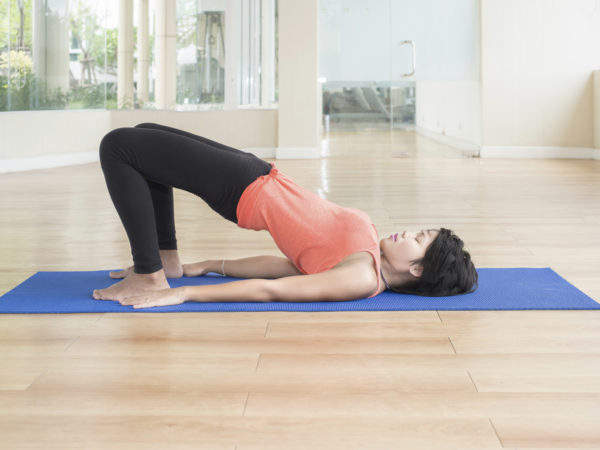Bridge Pose

“You can practice the Bridge Pose to both strengthen and stretch your back. This pose also lengthens and loosens the hamstrings, improving circulation and promoting overall relaxation.” – Andrew Weil, M.D.
Description & History
The yoga pose known in English as the Bridge Pose is called Setu Bandha Sarvangasana in Sanskrit, which translates literally as “construction of a bridge.” The pose name comes from the words setu meaning bridge, bandha meaning lock, sarvanga meaning limb, and asana meaning posture. The Bridge Pose is commonly used to stretch and strengthen the back and abdominal muscles as well as open the lungs and chest.
How to Perform the Bridge Pose
- Begin in supine position on floor. If necessary, place a folded blanket or yoga mat under shoulders to protect upper back and neck. With bent knees, place feet flat on the floor and parallel, no more than hip-width apart. Keep arms to the side of your body with palms on the floor for stability.
- Exhale and slowly lift hips toward the ceiling, keeping the knees and thighs parallel. Engage the muscles of your lower back, buttocks, thighs and abdomen to keep the body taut and firm. Lift the hips until the body is flat from chest to knees.
- Keep the neck loose by lifting the chin away from the body. This movement will help you to avoid placing too much strain on the neck.
- Maintain the pose for 30 seconds to one minute. Once you are ready to release, exhale and slowly roll the spine down starting from the neck and ending at the hips, one vertebra at a time. Repeat the pose once more if your body feels comfortable.
Potential Health Benefits
- Stretches the back and can alleviate low back pain
- Opens chest and hip flexors
- Strengthens abdominals and core muscles
- Improves digestion
- Improves flexibility of the spine and hips
Yoga poses that focus on the lower back such as the Bridge Pose have been shown to alleviate back pain. Investigators compared the effects of yoga and physical exercise on patients who experience chronic lower back pain. During a seven-day period, investigators found the patients who engaged in yoga had a greater improvement in spinal flexibility and a reduction in lower back pain than those patients who engaged only in physical exercise. The study was published in the June 2012 edition of the Complementary Therapies in Medicine.
Modifications & Variations
Beginners must keep the shoulders rolled under to prevent overstretching the neck. Lift the top of the shoulders toward the ears and push the shoulder blades away from the spine.
Beginners should also start with a yoga block under the sacrum (also known as the “tailbone,” the small triangular bone at the base of the spine) to alleviate pressure on the back. Start with the yoga block to the side of the body and move it under the sacrum once the body is in the Bridge Pose. Once the yoga block is in place, the body can return to the start position and rest atop the block.
Advanced practitioners can perform two extra movements to “deepen” the Bridge Pose. One is to extend the arms and place them above the head with the backs of the hands and arms on the floor. This movement engages the muscles of the body by reducing stability the arms provided. Advanced practitioners can also lift the heels off the floor and lift the hips higher.
Precautions
People with knee, back, or neck pain should avoid performing the Bridge Pose without consulting a doctor. It is important to ensure your shoulder blades are supporting your full weight and not your neck. It is recommended that you place a folded towel or yoga mat under the shoulders to prevent slipping on the floor and to reduce pressure on the neck and shoulders. As you do bridge pose, you can also interlace your fingers, place them under your buttocks and press them down into the mat. This will increase stability.
Related Poses
- Cobra Pose (Bhujangasana)
- Supported Shoulder Stand (Salamba Sarvangasana)
- Upward-Facing Dog (Urdhva Mukha Svanasana)
- Upward Bow or Wheel Pose (Urdhva Dhanurasana)
Reviewed by: James Nicolai, M.D., on May 20, 2013
Sources
Tekur, P., R. Nagarathna, S. Chametcha, Alex Hankey, and H. R. Nagendra. “A comprehensive yoga programs improves pain, anxiety and depression in chronic low back pain patients more than exercise: an RCT.” Complementary Therapies in Medicine 20, no. 3 (2012): 107-118. 10.1016/j.ctim.2011.12.009









